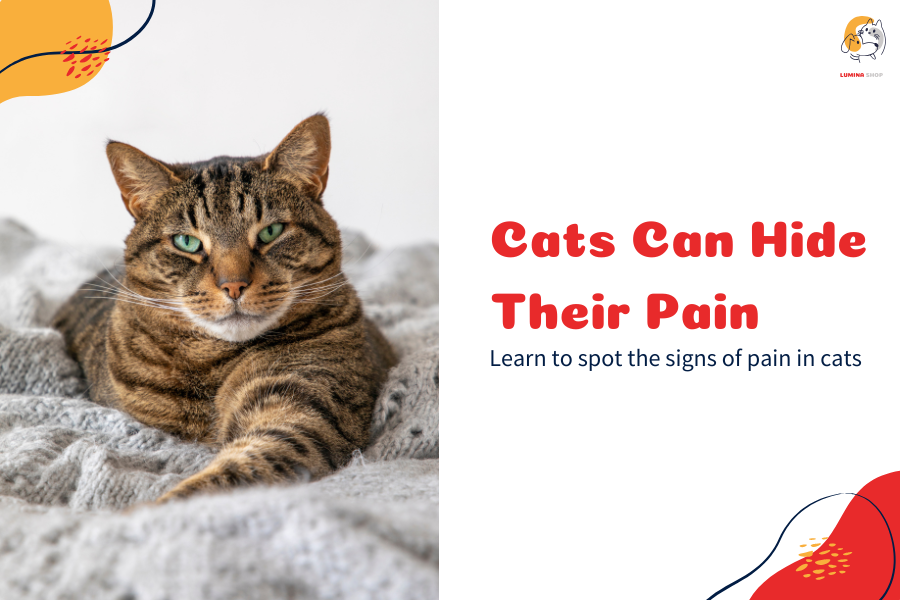
How to Tell If Your Cat Is in Pain ?
Cats are masters of mystery—especially when it comes to pain. Unlike dogs, who might whimper or limp when they’re hurt, cats often hide their discomfort. This natural instinct makes it tricky for pet parents to recognize when something is wrong. But don’t worry! If you know what to look for, you can catch the signs early and help your furry friend feel better.
Let’s dive into the subtle (and not-so-subtle) signs of pain in cats and what you can do to help.

1. Changes in Behavior: The First Red Flag
A sudden shift in your cat’s behavior is often the first sign something’s off. Here are a few things to watch for:
🐾 Hiding More Than Usual – Is your cat suddenly spending all day under the bed? They might be trying to avoid contact due to pain.
🐾 Less Playful, More Lethargic – If your once-energetic kitty is now lying around all day, it could be a sign they’re uncomfortable.
🐾 Avoiding the Litter Box – Struggling to get in and out of the box or accidents outside of it might indicate joint pain or another underlying issue.
🐾 Irritability or Aggression – A normally sweet cat that hisses or swats when you try to pet them might be telling you, "Ouch, that hurts!"
🐾 Grooming Too Much—or Not Enough – Excessive licking of one spot could mean pain, while a lack of grooming may suggest they’re too uncomfortable to bother.

2. Physical Signs You Shouldn't Ignore
Sometimes, the clues are more physical than behavioral. Here are some body language signals that may indicate pain:
😿 Limping or Stiff Walking – If your cat seems to have trouble jumping onto furniture or hesitates before moving, they might have joint pain.
😿 Hunched Posture – A cat that sits with an arched back and tucked-in paws might be feeling unwell.
😿 Facial Expressions Matter – Squinting eyes, flattened ears, and a tense jaw are all potential indicators of discomfort.
😿 Heavy Breathing or Panting – Unlike dogs, cats don’t usually pant unless they’re overheated or in distress. If you notice this, it’s time to call the vet.

3. Meowing More—or Less? Vocal Clues to Pain
Your cat’s voice can be a big indicator of how they feel. If you notice any of these changes, pay attention:
🔊 More Meowing Than Usual – If your cat is suddenly super chatty, especially in a distressed or urgent tone, they might be trying to tell you something.
🔊 Growling or Yowling – If your cat growls when touched or makes unusual sounds when moving, pain could be the cause.
🔊 Unusual Silence – On the flip side, if your normally talkative cat has gone quiet, that could also be a sign something’s wrong.

4. Acute vs. Chronic Pain: What’s the Difference?
Understanding acute vs. chronic pain can help you figure out what’s going on:
🩹 Acute Pain – Happens suddenly due to injury, surgery, or illness. For example, a sprained paw or a bite wound.
🩺 Chronic Pain – Develops over time, often due to arthritis, dental disease, or long-term conditions. It’s subtle and can be harder to detect.

5. When Should You Call the Vet?
If you notice multiple signs of pain or if your cat’s behavior changes drastically, it’s always best to check with your vet. Early detection can prevent suffering and keep your cat happy and comfortable.

Final Thoughts: Helping Your Cat Feel Their Best
Cats might be great at hiding pain, but you can be even better at spotting it! By paying attention to small changes in behavior, body language, and vocalization, you can catch the signs early and get your feline friend the care they need.
💙 Want to keep your pet happy and healthy? Check out our selection of cat-friendly products at Lumina Pet Shop for everything from cozy beds to soothing toys. Because a comfortable cat is a happy cat!
